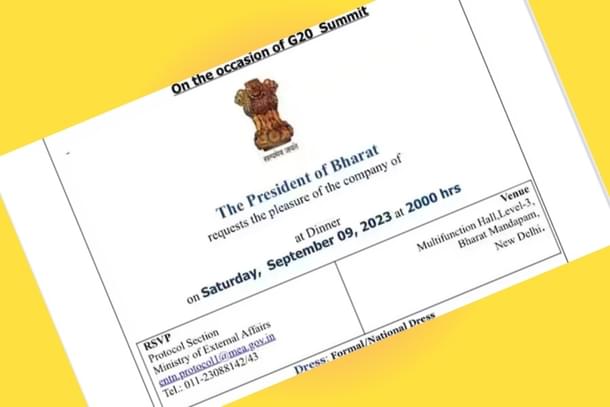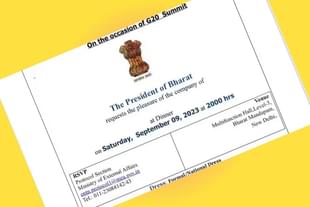Politics
Bharat: Beyond Pop-Mythology
Aravindan Neelakandan
Sep 23, 2023, 04:09 PM | Updated 04:09 PM IST
Save & read from anywhere!
Bookmark stories for easy access on any device or the Swarajya app.


When various official invitations for the G20 summit events, including those from the President, used the title 'President of Bharat', it led to controversy and speculation about the BJP Government's intentions to rename the nation.
However, it seems the Government only aims to promote the use of 'Bharat' alongside 'India', aligning with the constitutional reference of 'India that is Bharat'.
Sections of the mainstream media promptly expressed disapproval. Most of these criticisms were openly political, accusing the Modi Government of feeling threatened by the I.N.D.I Alliance and thus trying to rename the country.
But joining these political voices, was the voice of pop-mythologist Devdutt Pattanaik. He said:
First, the word Bharatvarsh was carved in stone about 2100 years ago in Odisha in the Hathigumpha caves. You find this word Bharatvarsh but it is referring only to the Gangetic region, not to the entire India. So, the word Bharatvarsh refers to a certain part of North India…and it is a name given by Brahmins. So, when people say Bharat, Bharatkhand, Bharatvarsh, these are coming from Brahmin sources…something like an Aryadesh, the land of Aryans. Bharata is a victorious king of the Aryans. So, it is a very North Indian Brahminical word that emerges. North Indian Bharat comes from Brahmin traditions and South Indian Bharat comes from Jain traditions'Business Today' report dated Sep-8-2023
The quoted passage above is intriguing for a multitude of reasons. It artfully crafts an illusion of impartial academic critique. However, beneath this facade, it not only reveals the superficiality of Pattanaik’s understanding but also lays bare his cultural ignorance.
When such questionable posturing merges with shallow knowledge and cultural illiteracy, it naturally seeks refuge in the final sanctuary of every sub-mediocre 'intellectual' in this nation—the alleged deep-seated north-south divide.
Suddenly, even Bharat transforms into a Jain entity in the south and a ‘Brahminical’ one in the north.
Nonetheless, let us delve into the assertions made by the pop-mythologist and ascertain if there is any substance to his claims.
We shall commence with the assertion that 'Bharat' is non-Brahminical and Jain in southern India.
The Purananooru, belonging to the oldest stratum of the Sangam corpus, offers a compelling counterpoint.
It is replete with verses that depict the entire land from the Himalayas to Kanyakumari as a unified entity. Its content is unmistakably Vedic.
Brahmins are portrayed as esteemed scholars who were an integral part of ancient Tamil life.
Here one should remember that Purananooru is not Bhakti literature or sacred scripture. It is a ‘secular’ text in that it extols the martial prowess and bravery of the Tamil people. That such a text employs metaphors and similes that venerate the Vedas and consider the nation as one actually shows how deep-rooted is the Vedic national unity in Tamil conscience.
Consider the following poem which wants the fame of a Pandya king to spread beyond his own land.
The king incidentally had the title ‘king who had conducted multiple Yajnas’. So the poet sings how his fame should spread beyond his territory by defining the frontiers:
Beyond the land whose boundaries are held by snow-clad Himalayas in the north, beyond the south of Kumari, East of the new sea and west of the old sea, and through the three-tires upwards reaching the cow-realm, downward reaching nether-worlds, let your fame spread...Purananooru : 6
It's acknowledged that the king in question didn't have political control over the entire nation. This emphasizes the importance of our discussion. The poet saw the nation as a unified whole, regardless of kingdom boundaries.
It's worth noting that the eastern sea is described as a man-made one, unlike the natural sea on the western border. This connects to the Puranic belief that the eastern sea was created by Sakaras.
The three-tiered cosmology presented here, often attributed to Indo-European influence by many Indologists, is also significant. The depiction of Go-Loka (cow realm) above as the ultimate destination of ascension aligns with Vaishnavaite Puranic beliefs.
The presence of these Puranic or proto-Puranic elements in poems from the oldest sections of Sangam literature clearly shows that defining Bharat’s boundaries and its people as Bharatis in the Vishnu Purana—a layered text dating from 300 BCE with its last update no later than circa 450 CE—has a longstanding tradition.
This discussion traces back to the Harappan civilization.
Eminent scholar Iravatham Mahadevan (1930-2018), who devoted his life to studying ancient inscriptions, especially the Harappan script, proposed a unique theory about the Harappan culture.
While he supported the Indo-European (IE) migration model, he consistently found Vedic ritual symbols in Harappan seals. This led him to conclude that the Indus Valley Civilization was culturally Vedic, even if its language was Dravidian or proto-Dravidian.
In a touching yet scholarly lecture, he reflects on the message of the Indus Script as he sees it:
The Indus heritage is shared by Dravidian as well as Indo-Aryan speakers. The Dravidian heritage is linguistic. The Indo-Aryan heritage is cultural preserved through loanwords, loan translations and myths.... Interpretation of the Indus Script through bilingual parallels has revealed hitherto unsuspected links among different languages and regional cultures. Thus the Indus-Dravidian title of poṟ-ay ‘sustainer’ borne by the priestly office-bearers of the Indus Civilisation survived as Poṟai, the Cēra dynastic name in the far South. The same Indus title was translated in Vedic Sanskrit as Bharata, the name of an important people in the RV. They are also the central figures in the Mahābhārata, our national epic. The Bharatas gave our country its name Bhārata. In yet another variation of the same tradition, the Andhra dynasty, speaking Telugu, a Dravidian language, translated their names into Indo-Aryan (Sātakarṇi, Sātavāhana and Sālivāhana), as they were vassals of the Mauryan dynasty whose court language was Prakrit. As I read it, the message of the Indus Script is: unity in diversityConvocation lecture delivered at Dravidian University, Kuppam on 26 February 2015
It is imperative to note that Mahadevan ardently dismissed the notion of a substantial Indo-European presence in the Harappan civilization. He proposed that the Vedas incorporated elements from the Harappans through subsequent borrowing.
However, contemporary evidence strongly suggests the existence of Indo-European languages in Harappa, a fact that should be taken into consideration when interpreting the aforementioned passage.
The etymological origin of the term ‘Bharat’ is intriguingly similar to the title ‘poṟ-ay/Porai’ used by the Chera royal dynasty in the deep south. Both terms, derived from the root ‘bhr-’ in Sanskrit and ‘porai’ in Tamil respectively, signify ‘to bear’ or ‘to carry’.
Furthermore, the Tamil word ‘Porumai’, denoting patience, also shares this root. The phonetic resemblance between ‘bhr’ and ‘porai’, coupled with their shared semantic field, is unlikely to be mere coincidence.
Therefore, it can be inferred that the term ‘Bharat’, along with its pan-Indian connotation and association with Vedic Yajna, also encapsulates within it a symbolic linguistic diversity.
In 1959, the then government issued a White Paper titled ‘Historical Background of the Himalayan Frontier of India’. Within this is the following passage:
This northern frontier of India is for much of its length the crest of the Himalayan ranges. The Himalayas have always dominated Indian life, just as they have dominated the Indian landscape. One of the earliest Sanskrit texts, though its exact date is uncertain-the Vishnu Purana-makes it clear that the Himalayas formed the frontier of India. It states that the country south of the Himalayas and north of ocean is called Bharat, and all born in it are called Bharatiyas or Indians. uttaram yat samudrasya himadres caiva daksinam varsham tad (tam ) bharatam nama bharati yatra santatih.
And as for the pop-mythologist’s relentless fixation on fabricating a Brahmin/non-Brahmin, North/South divide in Bharat where none exists - one can only quote the Bhagavad Gita - sarvarthan viparitansh cha buddhih sa partha tamasi (18:32).




